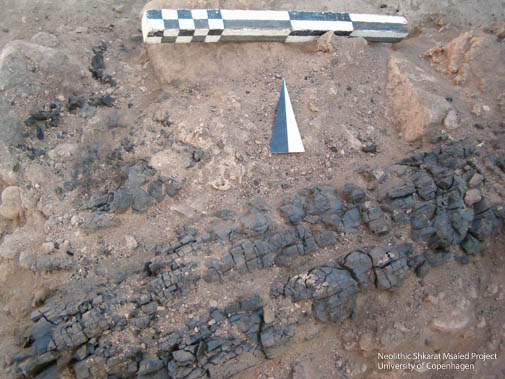Paleobotany
The Shkarat Msaied Plant Remains: Preliminary Observations (2002)
by Mette Marie Hald
During the 2002 study season at Shaqarat Masyad, roughly 30 soil samples were taken for archaeobotanical analysis. As no actual excavation was taking place on site, the samples were taken from two types of context: a) already exposed surfaces that clearly contained charred material, and b) every clearly distinguished layer in the baulks that were removed as part of the research strategy of this season. During previous excavation seasons 114 soil samples had also been taken from various contexts and left in storage. During a brief visit on site by the author in 2002, 19 samples of between 0.5 and 40 litres were floated, both recent samples and samples from previous seasons, as described above. All samples were floated by hand, the flots were retained in a 0.3 mm sieve and the samples have subsequently been scanned to assess the contents and richness of the botanical material.
All of the samples contained charred botanical material and the overall preservation is variable. Of the 19 samples that were floated, nine samples contained only charcoal and three samples contained a few indeterminate plant remains. The remaining seven samples contained a few large grasses and a larger proportion of wild plant varieties as well as charcoal. The large grasses resemble emmer wheat (T. diccocum). A total of only four grains and the lack of chaff means that a determination of the stage of domestication will have to wait until more plant material has been recovered.
Of the wild plants, Aegilops sp., Malva sp. and the legumes Medicago sp. and Astragalus sp. are present in many of the samples, as are weeds of the Cyperaceae family. Common for the above species, apart from Astragalus sp., is a relatively high water requirement, and their presence therefore suggests that the environment around Shaqarat Masyad was wetter in the past than it is today.
There was one possible food plant found in the samples – wild pistachio, Pistacia sp. This plant type is relatively common throughout the samples and occurred in very large numbers in trench F95/F100. It has not yet been possible to determine this Pistacia to species due to the lack of sufficient reference material, but large numbers of P. atlantica were found at the nearby, contemporaneous site of Beidha (Helbaek 1966), suggesting that one or more species of wild pistachio may have played a significant role in the economy of PPNB sites in this region.
It is hoped that future analysis of the remaining Shaqarat Mazyad archaeobotanical samples will cast a more detailed light on the food economy of the site. A further 62 samples were floated during the 2004 spring season and are awaiting initial examination.
References
Helbaek, H. 1966. Pre-Pottery Neolithic Farming at Beidha. Palestine Exploration Quarterly 98: 61-66.
For further enquiries please contact PhD Mette Marie Hald Arslan.

